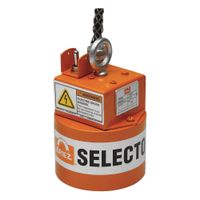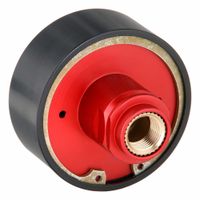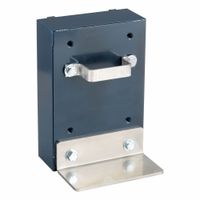Call +(254) 703 030 000 / 751 483 999 / 721 704 777
- Home
- Material Handling
- Lifting Pulling Positioning
- Lifting Magnets
.....Read More
Frequently Asked Questions
What are the different types of lifting magnets?
Lifting magnets are devices used to lift and transport ferrous materials. They come in various types, each suited for specific applications:
1. **Permanent Lifting Magnets**: These use permanent magnets to generate a magnetic field. They do not require electricity, making them energy-efficient and reliable. They are ideal for lifting flat and round ferrous objects and are commonly used in workshops and warehouses.
2. **Electromagnets**: These magnets use an electric current to generate a magnetic field. They can be turned on and off, providing greater control over the lifting process. Electromagnets are suitable for heavy-duty applications and can lift large and heavy objects. They require a continuous power supply and are often used in industrial settings.
3. **Battery-Powered Lifting Magnets**: Combining the features of permanent magnets and electromagnets, these use a battery to control the magnetic field. They offer the flexibility of electromagnets without the need for a constant power source, making them portable and versatile for various applications.
4. **Electro-Permanent Magnets**: These magnets use a combination of permanent magnets and electromagnets. An electric pulse is used to switch the magnetic field on or off, but no power is needed to maintain the magnetic field. They offer the safety of permanent magnets with the control of electromagnets, making them suitable for both heavy and delicate lifting tasks.
5. **Ceramic Magnets**: Made from ceramic materials, these are cost-effective and provide a strong magnetic field. They are often used in applications where cost is a significant factor.
6. **Rare Earth Magnets**: Composed of rare earth elements like neodymium, these magnets are extremely powerful and compact. They are used in applications requiring high magnetic strength in a small form factor.
Each type of lifting magnet has its advantages and is chosen based on the specific requirements of the lifting task, such as load size, weight, and operational environment.
How do electromagnetic lifts work?
Electromagnetic lifts, often referred to as maglev (magnetic levitation) systems, operate using the principles of electromagnetism to lift and propel objects without physical contact. These systems primarily rely on two key electromagnetic principles: magnetic repulsion and attraction.
In a maglev lift, electromagnets are strategically placed along the guideway and on the lift itself. When electric current passes through these electromagnets, they generate magnetic fields. By carefully controlling the current, the magnetic fields can be manipulated to create either attraction or repulsion forces.
For levitation, the system uses repulsion. Electromagnets on the lift and the guideway are configured so that like poles face each other, creating a repulsive force that lifts the lift off the ground. This eliminates friction, allowing for smooth and efficient movement.
For propulsion, the system employs a linear motor, which is essentially an unrolled version of a conventional electric motor. The guideway contains a series of electromagnets that are sequentially activated to create a moving magnetic field. This field interacts with magnets on the lift, pulling it forward. By adjusting the frequency and phase of the current, the speed and direction of the lift can be precisely controlled.
Electromagnetic lifts offer several advantages, including reduced mechanical wear due to the lack of contact, lower maintenance costs, and the potential for high-speed travel. However, they require sophisticated control systems and significant energy input to maintain the magnetic fields necessary for levitation and propulsion.
What are the advantages of using lifting magnets in automated processes?
Lifting magnets offer several advantages in automated processes:
1. **Efficiency**: Lifting magnets enable quick and efficient handling of ferrous materials, reducing the time required for loading, unloading, and transporting materials. This efficiency is crucial in automated systems where speed and precision are paramount.
2. **Safety**: By minimizing the need for manual handling, lifting magnets reduce the risk of workplace injuries. They eliminate the need for slings, hooks, and chains, which can pose safety hazards.
3. **Cost-Effectiveness**: Lifting magnets reduce labor costs by automating material handling tasks. They also decrease the wear and tear on equipment, leading to lower maintenance costs.
4. **Versatility**: These magnets can handle a wide range of materials, from small parts to large steel plates, making them suitable for various applications in manufacturing, warehousing, and shipping.
5. **Precision**: Lifting magnets provide precise control over the positioning and movement of materials, which is essential in automated processes that require high accuracy.
6. **Space-Saving**: By eliminating the need for bulky lifting equipment, lifting magnets help optimize space utilization in facilities, allowing for more efficient layout and workflow.
7. **Energy Efficiency**: Permanent lifting magnets do not require a continuous power supply, reducing energy consumption. Even electromagnets, when used efficiently, can contribute to energy savings in automated systems.
8. **Reduced Downtime**: The reliability and durability of lifting magnets lead to fewer breakdowns and maintenance interruptions, ensuring continuous operation in automated processes.
9. **Environmental Benefits**: By reducing the need for consumables like slings and chains, lifting magnets contribute to a more sustainable and environmentally friendly operation.
Overall, lifting magnets enhance the productivity, safety, and cost-effectiveness of automated processes, making them a valuable tool in modern industrial operations.
How do you safely operate below-the-hook lifting magnets?
To safely operate below-the-hook lifting magnets, follow these guidelines:
1. **Training and Certification**: Ensure operators are trained and certified in handling lifting magnets and understand the specific equipment's operation manual.
2. **Inspection**: Conduct pre-use inspections to check for damage, wear, or malfunction. Inspect the magnet face, electrical connections, and control systems.
3. **Load Assessment**: Verify the load's weight, shape, and material to ensure it is within the magnet's capacity and suitable for magnetic lifting.
4. **Surface Condition**: Ensure the load's surface is clean and free of debris, rust, or coatings that could reduce magnetic effectiveness.
5. **Positioning**: Center the magnet over the load to ensure even weight distribution and maximum magnetic contact.
6. **Engagement**: Gradually engage the magnet, ensuring full contact with the load before lifting. For electromagnets, ensure the power supply is stable.
7. **Lifting**: Lift the load slowly and steadily to avoid sudden movements. Keep the load close to the ground initially to check stability.
8. **Transport**: Move the load smoothly, avoiding sudden stops or changes in direction. Keep the load as low as possible to minimize swing.
9. **Environment**: Be aware of environmental factors like temperature and humidity that can affect magnet performance.
10. **Communication**: Maintain clear communication with all personnel involved in the lifting operation. Use hand signals or radios if necessary.
11. **Deactivation**: Once the load is placed, ensure the magnet is fully deactivated before detaching. For permanent magnets, use the release mechanism properly.
12. **Storage**: Store magnets in a clean, dry area when not in use to prevent damage and maintain performance.
13. **Maintenance**: Regularly maintain and test magnets according to the manufacturer's guidelines to ensure ongoing safety and efficiency.
What are the applications of end-of-arm transporter lifting magnets?
End-of-arm transporter lifting magnets are versatile tools used in various industrial applications to enhance efficiency, safety, and precision in material handling processes. Here are some key applications:
1. **Automotive Manufacturing**: In automotive assembly lines, these magnets are used to lift and position metal parts such as car doors, hoods, and chassis components. They streamline the assembly process by allowing for quick and secure handling of heavy and awkwardly shaped parts.
2. **Metal Fabrication**: In metal fabrication shops, lifting magnets are employed to move steel plates, sheets, and beams. They facilitate the loading and unloading of cutting machines, welding stations, and presses, reducing manual labor and minimizing the risk of injury.
3. **Warehousing and Logistics**: Lifting magnets are used in warehouses to handle ferrous materials, such as steel coils and bundles of metal rods. They improve the efficiency of stacking, sorting, and transporting materials, optimizing space utilization and inventory management.
4. **Construction**: On construction sites, these magnets assist in the handling of steel beams, rebar, and other metal components. They enable precise placement and alignment, which is crucial for structural integrity and safety.
5. **Shipbuilding**: In shipyards, lifting magnets are used to move large steel plates and sections of the hull. They support the assembly of ships by allowing for the precise positioning of heavy components, which is essential for maintaining the structural balance of the vessel.
6. **Recycling and Scrap Yards**: Lifting magnets are employed to sort and move ferrous scrap materials. They enhance the efficiency of recycling operations by quickly separating metal from non-metal materials, facilitating the processing and transportation of scrap.
7. **Aerospace**: In the aerospace industry, lifting magnets handle metal components used in aircraft manufacturing. They ensure the safe and precise movement of parts, which is critical for maintaining the high standards required in aerospace engineering.
How do manual lifting magnets differ from electromagnetic lifts?
Manual lifting magnets and electromagnetic lifts differ primarily in their power source, operation, and applications:
1. **Power Source**:
- **Manual Lifting Magnets**: These rely on permanent magnets to generate a magnetic field. They do not require electricity to operate, making them energy-efficient and suitable for environments where power sources are unavailable.
- **Electromagnetic Lifts**: These use an electric current to create a magnetic field. They require a continuous power supply to maintain their magnetic force, allowing for control over the magnetization and demagnetization process.
2. **Operation**:
- **Manual Lifting Magnets**: Operated by a lever or handle, these magnets can be turned on or off manually. The magnetic field is constant and does not fluctuate, providing a stable lifting force.
- **Electromagnetic Lifts**: Controlled electrically, these magnets can be easily turned on or off with a switch. The strength of the magnetic field can be adjusted by varying the electric current, offering flexibility in handling different loads.
3. **Applications**:
- **Manual Lifting Magnets**: Ideal for smaller, lighter loads and environments where electricity is not feasible. They are commonly used in workshops, small-scale manufacturing, and situations requiring portability.
- **Electromagnetic Lifts**: Suitable for heavy-duty applications, such as in steel mills, scrap yards, and large-scale manufacturing. They are preferred for lifting heavy and bulky ferrous materials due to their adjustable magnetic strength.
4. **Safety and Maintenance**:
- **Manual Lifting Magnets**: Generally safer as they do not rely on electricity, reducing the risk of power failure. They require minimal maintenance.
- **Electromagnetic Lifts**: Require regular maintenance to ensure electrical components function correctly. Power failures can pose safety risks if not managed properly.
In summary, manual lifting magnets are simpler, more portable, and energy-efficient, while electromagnetic lifts offer greater control and are suited for heavy-duty industrial applications.
What safety precautions should be taken when using lifting magnets?
When using lifting magnets, several safety precautions are essential to ensure safe operation and prevent accidents:
1. **Inspection and Maintenance**: Regularly inspect the magnet for wear, damage, or malfunction. Ensure that all components, including the lifting eye and electrical connections, are in good condition. Perform routine maintenance as per the manufacturer's guidelines.
2. **Load Capacity**: Never exceed the magnet's rated load capacity. Consider the weight, shape, and material of the load, as well as any factors that might reduce the magnet's effectiveness, such as surface conditions or air gaps.
3. **Surface Conditions**: Ensure that the contact surfaces of both the magnet and the load are clean, dry, and free from rust, paint, or debris to maximize magnetic force.
4. **Proper Alignment**: Align the magnet correctly with the load to ensure even distribution of magnetic force. Misalignment can lead to slippage or detachment.
5. **Operator Training**: Ensure that all operators are adequately trained in the use of lifting magnets, including understanding the equipment's limitations and emergency procedures.
6. **Safety Zones**: Establish and enforce safety zones around the lifting area. Keep personnel clear of the load's path and potential drop zones.
7. **Use of Safety Straps**: When possible, use additional safety straps or chains as a backup in case of magnet failure.
8. **Environmental Conditions**: Be aware of environmental factors such as temperature, humidity, and electromagnetic interference that may affect the magnet's performance.
9. **Emergency Procedures**: Have clear emergency procedures in place, including how to safely lower a load in case of power failure or magnet malfunction.
10. **Signage and Warnings**: Use appropriate signage to warn of magnetic fields and potential hazards, especially in areas where pacemakers or sensitive electronic devices may be affected.
By adhering to these precautions, the risk of accidents and injuries can be significantly minimized.




